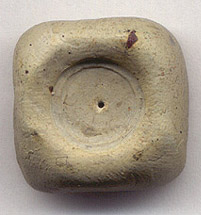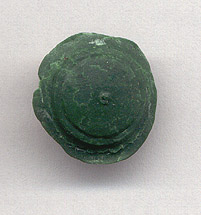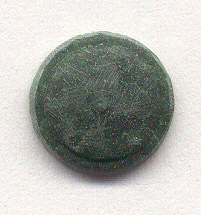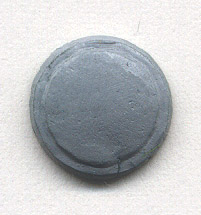|
Of all the techniques available to build your own models the simplest of all must be using pressure molds, yet for many little things this works fine and being unexpensive and very easy is a method really available to everyone... The basic idea is to press a master into a suitable material to create a mold. It is a method that has major limitations, most obviously that is only suitable for one-sided elements, but doesn't require any particolar equipment or material, which is why it is such a popular choice!
In this case I needed a greek hoplon shield for a few figures, and a pressure mold was perfect for the job. I've begun making a master using a viking shield from an old lead figure I had laying around. I've sanded down the central boss and the wood detail and given it the right dome shape, then filed down the outside rim. You can use Green Stuff to make your master but make sure you use a reliable mold release agent or you may have troubles to get it off the mold... 
|
The mold is just a blob of Milliput in which I've pushed in the master. Yu can use any epoxy putty or even FIMO to make the mold, they are actually better because being slightly flexible it's easier to release the casts, but make sure you test they can stand the temperature of the casting if you plan to use white metal tin alloys for it. If you get your casting metal from scrap tin figures you should have no problem as they are generally made of a bismuth rich alloy with a very low melting point. Old figures made of lead may have a much higher melting point and could burn the mold though.

|
The small pin hole in the middle allow air to escape and helped to remove the master. I used a cheap spray lubricant as release agent, just remember to let the mold dry a bit after you spray it.

|
The shields are then "casted" by pressing down a little bit of Fimo in the mold cavity. The mold is then baked for 30 minutes at 100° to cure the fimo. You can also cast your pieces using any epoxy putty like Green Stuff or Milliput provided you use a suitable release agent. Actually casting in white metal alloy is also possible but be very careful: molten metal is very dangerous and gives out toxic fumes! You need to wear proper protection and ensure adequate ventilation.

|
The cast after curing has a lot of extra material around as well as a relief mark where the pin hole was. (I've used some very old Fimo here which had hardened a bit, that's why it looks so uneven).

|
All of this is quickly taken care of with a sharp blade and some fine grade sand paper.

|
Now just prime...

|
...and paint away!

Ok, this doesn't look that good especially this close up (the actual shield is about 4 times smaller than you see here!), but it mostly has to do with the poor quality of the FIMO I've used and the quick paint job... you can get much better results using this technique with a bit of practice! |
|
|